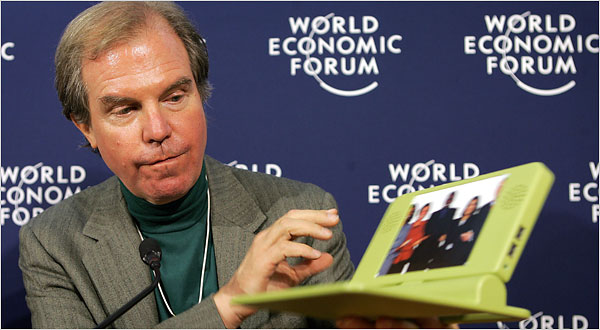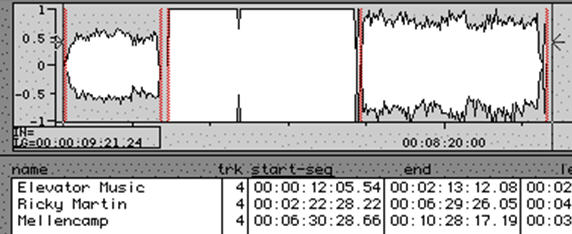View current page
...more recent posts
Edward B. Rackley on those $100 laptops for 3rd World kids we've been hearing so much about:
I'm soon headed to northern Uganda to research violations against children by the Lord's Resistance Army and the Ugandan National Army. I'll keep one eye skyward for any falling laptops--although such spacejunk is already common in rural Africa. I used to work with Dinka pastoralists in Southern Sudan who decorated their cattle by hanging discarded CDs from their horns. The CDs were recovered from the trash pits of international NGOs working to improve the lives of southerners during the war with Khartoum. Of course they had no idea what the CDs were, other than round reflective disks once used by foreigners. What would the Dinka do with laptops? Maybe trap wild game in the mighty jaws of the hinge mechanism connecting keyboard and screen.On discussions of the laptop at Davos:
Their debates over how to solve the global 'digital divide' bear the mark of all starry-eyed social engineering endeavors, with the world's digitally illiterate providing a conveniently captive set of guinea pigs. Lack of food, water, education and safety for many in the developing world apparently matter little when you can throw a $100 laptop at the problem.

"Nicholas Negroponte of M.I.T. shows off his $100 laptop"--NY Times caption and photo.
2001 [counter-directional arrows] 2006
Jason Kottke: "Nasty Nets used CSS positioning to 'embed' one YouTube video into another. 'Be sure to hit "play" on both YouTubes.' Reminds me of the animated GIF mashups (link)."
Hello, content? Who cares about CSS positioning?
As Theodor Adorno described the work: "An exquisite and in some ways exquisitely awful play of symmetries. The 1968 'state of the art' trip sequence from 2001: A Space Odyssey, its widescreen magnificence reduced to YouTube size, serves as a continuously running background to a smaller YouTube nested within its boundaries. The foreground film consists of a simple but somewhat relentless montage of photos made by teenagers playing with basic iPhoto effects, while Queen chugs along on the soundtrack.
"The split screen, mirror image appears in both foreground and background: one limns a cleavage in space-time, expansive, landscape-embracing, the other barrages the viewer with portrait grotesqueries, cartoonish Francis Bacon-like horrors caused by flipping selected facial features. Yet there are 'crossover points' where the faces widen and flatten into topographic arrays and the Kubrick film jumps to contorted portrait closeups of Keir Dullea's agonized face.
"The background clip has pretentions to high culture with its doom-laden Ligeti score and references to Modernist abstraction yet it is ultimately still a mass market popcorn movie. The teens' use of iPhoto exploits the most readily available computer imaging gimmicks such as 'spherizing' but is actually superior in its quick, intuitive sense of play to the ponderous 'high art' uses of the exact same tools by artists such as Lucas Samaras. As above so below, art mirrors the street and vice versa."
Update: I changed the title of this post because it was fuX0ring my RSS feed. I really, really, really hate the inflexibility of RSS and wish people would just bookmark me like in the old days.

"Let's go take another look at The Year in the Internet 2006!"
I've been enjoying this music on the WFMU download page (scroll down) from "an obscure bootleg of German minimal synth stuff from 1979-1983 entitled Kassettentater (Cassette Offender)." Especially good is the first track "Steig Den Luis Trenker" by 4172. Any help from a German language speaker on the content (just a rough idea) would be appreciated. The wikipedia bio on Trenker, an Austrian-Italian film director, architect, and actor, is interesting:
His first contact with film came in 1921, in which he helped director Arnold Fanck on one of his mountain films. The main actor could not perform the stunts required, and so Trenker assumed the leading role. He gradually assumed more roles on set, and by 1928 was directing, writing and starring in his films. By this year he had abandoned his job as an architect to concentrate on art and married Hilde Bleichert, with whom he had four children.Update: Thanks to drx for explaining that the song is a response to "Tanz den Mussolini" by DAF. He says:
The main theme of Trenker's work was the idealization of connection with the homeland and pointing out the decadence of city life. This loosely played into the hands of Nazi propagandists, who seized upon the nationalistic elements of his work. However, Luis refused to allow his work to subverted as such and eventually moved to Rome to avoid further governmental pressure. This, though, was not to be and after a pair of documentary films Trenker returned to Bolzano to quit making movies.
After the war Trenker was accused of fascist opportunism but eventually the charges were dropped. In the mid 1950s he again able to make movies, though by 1965 he had switched mainly to the documentary form, focusing mainly upon the Austrian Tyrol.
[T]he arrangement and lyrics are nearly identical. Instead of Hitler and Mussolini and Jesus Christus, this song covers some (at the time of recording) contemporary Germans and Austrians. Like actors (Harald Juhnke), publishers (Axel Springer), sportsmen (Niki Lauda, Toni Sailer) etc ... some i cannot understand. Probably they are dead already. But the ones i recognize have been very important or still are. Only some have to do with right wing stuff, like Axel Springer. Others had plane crashes or were just terrible people on TV every day.
Instead of "Dance the Mussolini" we have verbs that go with things these people were famous for, like "drink the Harald Juhnke", coz he was an alcoholic.
All DAF fans can for sure enjoy this bootleg :)

CD loudness comparison chart by Bob Katz. Edward R. Tufte would give this high marks for effective visual communication, plus it's funny. Sorry it's fuzzed out (drx, don't kill me)--the letters looked gimpy when I attempted an odd-number scale-up so Ph*t*sh*p had to be used.
"Song 15 (Nosebone)" [mp3 removed]
London, UK producer Brains has kindly remixed a couple of my tunes and encouraged me to pick up the pace a bit. This song is peppier (138 bpm) than the usual fare (90-120). It's done "live" in one take on that tangle of gear posted earlier.
Update: I will likely do another version with less of the high-pitched chirp-stabs.

When the U.S. President talks about American soldiers dying for "freedom," this is what he's referring to:
Iraq in Talks With Chevron, Exxon
Houston Chronicle
LONDON — Iraq is in negotiations with Chevron Corp. and Exxon Mobil Corp. to build a new $3 billion petrochemical facility, and is in talks with several other Western companies over industrial projects.
In an interview Thursday, Iraq's minister for industry and minerals Fowzi Hariri said the discussions with Chevron and Exxon began this week in Washington and are at an early stage.
"It will be one or the other company for this new facility, not both," he said. "We're hoping to have a (Memorandum of Understanding) in place by about July."
Hariri took his first trip to Washington early this week and met with several companies about industrial projects. The other leg of his trip took him to London, where he also met with a number of firms.
The minister, who has been in his post since last June, said the issue of security was a prominent feature of the discussions, given the sectarian conflict that has come to characterize Iraq over the past year. He said he emphasized to the companies that much of the violence has been in Baghdad. "What you see on the television is real ... but it's concentrated in the capital," said Hariri.
The discussions with the companies have been greatly aided by an Iraq foreign investment law that won final approval last October, he said.
Hariri said he hoped discussions with ABB Lummus, a unit of Swiss-Swedish electrical engineering company ABB Ltd., Dow Chemical Corp. and KBR Inc. over rehabilitating existing facilities would lead to tentative agreements by around March. "This is what we're hoping for but we will see," he said.
The contract with ABB Lummus could be worth $100 million, while Dow Chemical's contract could be $40 million to $50 million, the minister added. The contract forms for all the deals under discussion would include joint ventures.
While in the United States, the minister also held talks with the U.S. Geological Survey about performing a nationwide survey of Iraq's potential mineral base. He said he "had a good discussion" with the Export-Import Bank about possibly providing some of the financing for a nationwide survey to gauge Iraq's resources.
"We know we have iron ore and we think we have copper and probably gold," he said, adding that those opinions were based on old data.
Hariri plans to have discussions with General Electric Corp. over possible power turbine contracts and with General Motors Corp. over contracts for service vehicles, such as fire trucks and ambulances. The latter contract would be worth $80 million or less.
Over the next several years, the minister said Iraq would look to privatize all of state-owned industry, which number around 60 companies. He also said Asian companies were keen to enter discussions with the Iraqi government over industrial contracts.
Hariri said Iraq was also in discussions with San Francisco-based Bechtel Corp. over engineering contracts, but did not elaborate. The company recently said it was leaving Iraq after suffering through a spree of violence that killed 52 workers. The departure of the company served as another sobering reminder of how the carnage in Iraq has scrambled the United States' ambitions to rebuild the country.
